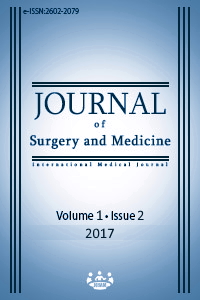Ten years ago, what was the main etiology of intestinal obstructions? Historical perspective: A retrospective cohort study.
Keywords:
Intestinal obstruction, Etiology, Hernia, Adhesions, NeoplasmsAbstract
Aims: Etiology of intestinal obstruction differs between countries. This study was designed to review a large series of patients with intestinal obstruction in an attempt to represent our historical aspect of experience in Turkey 10 years ago.
Methods: A review of the charts of 1387 patients admitted for intestinal obstruction during an 8-year period (2000 through 2007) was carried out.
Results: Cases were divided into two groups. Group A consisted of 1186 (85.5%) patients underwent operation. The remaining 201 (14.5%) patients managed non-operatively constituted group B. External strangulated hernias (inguinal, femoral, umbilical and incisional) were the most common cause of intestinal obstruction in group A, accounting for 46% of cases. Neoplasms and adhesions were common cause accounting for 19% and 18% of cases respectively.
Conclusion: External hernias are the most common cause of intestinal obstruction in our hospital. Increased efforts to repair external hernias electively before strangulation occurs are likely to reduce the incidence. Some major changes in etiology rank are present in current literature. New studies have to be performed to reveal current condition.
Downloads
References
Irvin T. Abdominal pain: a surgical audit of 1190 emergency admissions. Br J Surg 1989; 76: 1121-1125.
Bizer LS, Liebling RW, Delany HM, Gliedman ML. Small bowel obstruction: the role of non-operative treatment in simple intestinal obstruction and predictive criteria for strangulation obstruction. Surgery 1981; 89: 407-413.
Sosa J, Gardner B. Management of patients diagnosed as acute intestinal obstruction secondary to adhesions. Am Surg 1993; 59: 125-128.
Luckey A, Livingston E, Tache Y. Mechanisms and treatment of postoperative ileus. Arch Surg 2003; 138: 206-214.
Miller G, Boman J, Shrier I, Gordon PH. Etiology of small bowel obstruction. Am J Surg 2000; 180: 33-36.
de la Garza-Villasenor L. Etiology of intestinal occlusion. Rev Gastroenterol Mex 2001; 66: 193-196.
Ellis H, Moran BJ, Thompson JN, et al. Adhesion-related hospital readmissions after abdominal and pelvic surgery: A retrospective cohort study. Lancet 1999; 353: 1476-1480.
Miller G, Boman J, Shrier I, Gordon PH. Natural history of patients with adhesive small bowel obstruction. Br J Surg 2000; 87: 1240-1247.
Markogiannakis H, Messaris E, Dardamanis D, et al. Acute mechanical bowel obstruction: clinical presentation, etiology, management and outcome. World J Gastroenterol 2007; 13: 432-437.
Gurleyik E, Gurleyik G. Small bowel volvulus: a common cause of mechanical intestinal obstruction in our region. Eur J Surg 1998; 164: 51-55.
Erzurumlu K, Malazgirt Z, Bektas A, et al. Gastrointestinal bezoars: a retrospective analysis of 34 cases. World J Gastroenterol 2005; 11: 1813-1817.
Chou JW, Hsu CH, Liao KF, et al. Gallstone ileus: report of two cases and review of the literature. World J Gastroenterol 2007; 13: 1295-1298.
Stewart RM, Page CP, Brender J, et al. The incidence and risk of early postoperative small bowel obstruction. A cohort study. Am J Surg 1987; 154: 643-647.
Archampong EQ, Naaeder SB, Darko R. Changing pattern of intestinal obstruction in Accra, Ghana. Hepatogastroenterology 2000; 47: 185-193.
Ohene-Yeboah M, Adippah E, Gyasi-Sarpong K. Acute Intestinal Obstruction in Adults in Kumasi, Ghana. Ghana Med J 2006; 40: 50-54.
Downloads
- 3204 3353
Published
Issue
Section
How to Cite
License
Copyright (c) 2017 Yahya Kemal Çalışkan
This work is licensed under a Creative Commons Attribution-NonCommercial-NoDerivatives 4.0 International License.















